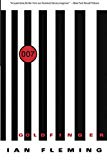
The character of Bond was developed more than in the previous novels; academic Jeremy Black considers that, in Goldfinger , Bond "was presented as a complex character". Continuation author Raymond Benson agrees, and sees Goldfinger as a transitional novel, with Bond becoming more human than in previous books and more concerned with what Benson calls "the mortal trappings of life", which manifest itself with the opening chapter of the book as Bond sits in Miami airport and thinks through his fight with and killing of a Mexican thug. Benson also sees that Bond has developed something of a sense of humour in Goldfinger , verbally abusing Oddjob, to Bond's own amusement.
Auric Goldfinger was described by Raymond Benson as "Fleming's most successful villain to date" and Fleming gives him a number of character flaws that are brought out across the novel. Psychologically Goldfinger is warped, possibly because of an inferiority complex brought on by his shortness, in contrast to a number of Fleming's other oversized villains and physically he is odd, with a lack of proportion to his body. As with a number of other villains in the Bond novels, there is an echo of World War II, with Goldfinger employing members of the German Luftwaffe, some Japanese and Koreans. For Operation Grand Slam, Goldfinger used the poison GB, now known as Sarin, which had been discovered by the Nazis. Goldfinger has an obsession with gold to the extent that academic Elizabeth Ladenson says that he is "a walking tautology". Ladenson lists both his family name and his first name as being related to gold ("Auric" is an adjective pertaining to gold); his clothes, hair, car and cat are all gold coloured, or a variant thereof; his Korean servants are referred to by Bond as being "yellow", or yellow-faced"; and he paints his women (normally prostitutes) gold before sex.
Elizabeth Ladenson thought the character of Pussy Galore to be "perhaps the most memorable figure in the Bond periphery." Galore was introduced by Fleming in order for Bond to seduce her, thereby proving Bond's masculinity of being able to seduce a lesbian. To some extent the situation also reflected Fleming's own opinions, expressed in the novel as part of Bond's thoughts, where "her sexual confusion is attributable to women's suffrage"; in addition, as Fleming himself put it in the book: "Bond felt the sexual challenge all beautiful Lesbians have for men." Ladenson points out that, unlike some Bond girls, Galore's role in the plot is crucial and she is not just there as an accessory: it is her change of heart that allows good to triumph over evil. In doing so, "Goldfinger himself...is a mere obstacle, the dragon to be got rid of before the worthy knight can make off with the duly conquered lady."
As with Ladenson's observation that Bond was being depicted as "the worthy knight", Raymond Benson also identifies the Saint George theme in Goldfinger , which he says has run in all the novels, but is finally stated explicitly in the book as part of Bond's thoughts after Goldfinger reveals he will use an atomic device to open the vault: "Bond sighed wearily. Once more into the breach, dear friend! This time it really was St George and the dragon. And St. George had better get a move on and do something". Jeremy Black notes that the image of the "latter-day St. George [is] again an English, rather than British image."
As with other Bond novels, such as Casino Royale , gambling is a theme, with not only golf as part of the novel, but opening with the canasta game as well. Raymond Benson identified times in the novel when Bond's investigation of Goldfinger was a gamble too and cites Bond tossing a coin to decide on his tactics in relation to his quarry. Once more (as with Live and Let Die and Dr. No ) it is Bond the British agent who has to sort out what turns out to be an American problem and this can be seen as Fleming's reaction to the lack of US support over the Suez Crisis in 1956 as well as Bond's warning to Goldfinger not to underestimate the English.
Already have an account? Log In Now